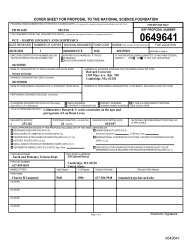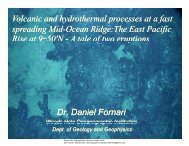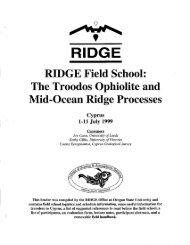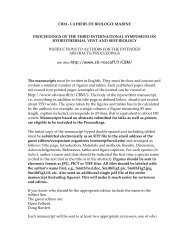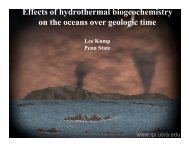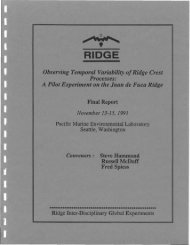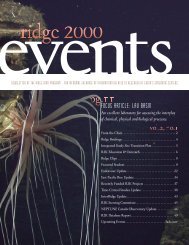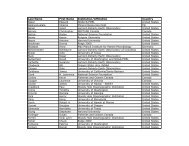Create successful ePaper yourself
Turn your PDF publications into a flip-book with our unique Google optimized e-Paper software.
2. Regional Surveys. Regional surveys should encompass<br />
several spreading segments and extend to at least 5 m. y. old<br />
crust. To characterize the physiography, full multibeam<br />
bathymetry and side-scan sonar coverage should be obtained, in<br />
conjunction with the acquisition of ship and airborne gravity<br />
and magnetic measurements (with a nominal spacing of not more<br />
than 5 km). These surveys should be followed or accompanied by<br />
the acquisition of marine seismic data, including multichannel<br />
seismic imaging along the ridge crest and along critical<br />
isochrons on the ridge flanks out to the 5 m. y. isochrons.<br />
Flow-line crossings should be conducted along several transects<br />
within each segment - adjacent to segment boundaries, across the<br />
center of a segment, and in I laces dominated by tectonism or<br />
volcanism. A suite of seismic refraction experiments should be<br />
conducted at several locations to define the deep structure of<br />
the ridge axis and of young oceanic lithosphere. These should<br />
be done at critical isochrons surveyed by reflection profiling.<br />
Microearthquake studies using arrays of on-bottom instruments<br />
should be made to describe the tectonics within the area of the<br />
seismic refraction experiments. The initial morphologic surveys<br />
will be used to guide systematic basement sampling on and<br />
off-axis, in conjunction with near-bottom photography, and other<br />
relevant in situ geophysical measurements.<br />
3. Detailed Local Studies. Detailed studies will be<br />
necessary at both the centers and the edges of spreading segments<br />
and may be separated into two groups: (1) studies that<br />
define the present architecture of the lithosphere and<br />
(2) studies that measure ongoing processes.<br />
The first group of studies requires geological mapping of<br />
the surface of the seafloor as well as investigations of the<br />
crust and mantle at depth. The geological mapping must be<br />
constrained by high resolution bathymetric and side scan sonar<br />
mapping base and include the areal extent of outcropping<br />
basement and surficial units, the locations and orientations of<br />
faults, fissures, ductile deformation features and any movement<br />
indicators on them, and active hydrothermal systems. Direct<br />
outcrop sampling is necessary for geochemical studies and<br />
oriented samples are essential for structural and magnetic<br />
studies. Detailed sampling and mapping of fault scarps could<br />
yield data on the volcanic and possibly plutonic stratigraphy of<br />
the crust. the crack structure and history of subsurface rocks,<br />
the alteration history of the crust, and the deep structure of<br />
hydrothermal systems. Developing a three-dimensional picture of<br />
the lithosphere is an integral part of these studies and it is<br />
likely that the most important data will come from direct<br />
sampling by deep drilling (kilometers depth) and shallower holes<br />
Ieven a few meters). Downhole logging and other experiments are<br />
needed to define the physical properties of rocks at depth.<br />
Correlations between physical properties and geophysical interfaces<br />
mapped from the regional surveys could produce a quantum<br />
leap in interpreting seismic structure. Gravity, magnetic and<br />
34




